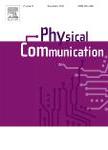版权所有:内蒙古大学图书馆 技术提供:维普资讯• 智图
内蒙古自治区呼和浩特市赛罕区大学西街235号 邮编: 010021

作者机构:Beijing Univ Posts & Telecommun Key Lab Universal Wireless Commun Beijing 100876 Peoples R China GuangDong Commun Networks Inst Guangzhou 510700 Guangdong Peoples R China Beijing Informat Sci & Technol Univ Sch Informat & Commun Engn Beijing 100101 Peoples R China NUAA Minist Ind & Informat Technol Key Lab Dynam Cognit Syst Electromagnet Spectrum Nanjing 211106 Peoples R China
出 版 物:《PHYSICAL COMMUNICATION》 (实体层通信)
年 卷 期:2020年第43卷
页 面:101180-101180页
核心收录:
学科分类:0810[工学-信息与通信工程] 0808[工学-电气工程] 08[工学] 0812[工学-计算机科学与技术(可授工学、理学学位)]
基 金:National Key Research and Development Program of China [2019YFB1804400] National Natural Science Foundation of China [61801052, 61941102] Beijing Natural Science Foundation [4202046, 19L2022] Key Laboratory of Dynamic Cognitive System of Electromagnetic Spectrum Space (Nanjing Univ. Aeronaut. Astronaut.), Ministry of Industry and Information Technology [KF20181901] Key Laboratory of Universal Wireless Communications (Beijing University of Posts and Telecommunications), Ministry of Education, P.R.China [KFKT-2016101]
主 题:Automatic modulation classification Deep learning Internet of Things security Multi-module fusion neural network Pixel-coloring constellation images
摘 要:The Internet of Things (IoT) is increasingly flourishing with establishing ubiquitous connections in every aspect of our daily lives and industrial production. However, the active physical-layer threats such as spoofing and jamming largely degrades the communication performance and makes the IoT network messy. Automatic modulation classification (AMC), which identifies the modulation formats of the active attack, plays a vital role in physical-layer security of IoT. In this paper, a multi-module fusion neural network (MMFN) is proposed to identify the signal modulations using a novel feature named pixel-coloring constellation images (PCCs). Specifically, a pixel-coloring constellation projection algorithm (PCCP) is proposed to convert raw modulated signals into PCCs, which are the inputs of the following MMFN. The MMFN is proposed to extract discriminative features and make the final classification decisions. In MMFN, multi-module fusion strategy is adopted to possess a strong representation ability and the characterization module is designed to balance the tradeoff between the number of parameters and the dimensions of extracted representative features. Simulation results exhibit that the proposed MMFN scheme achieves 90% classification accuracy at 1 dB signal to noise ratio (SNR) when the symbol length is set as 2048, and it outperforms the recent deep learning based AMC methods, which demonstrates its superior classification performance. (c) 2020 Elsevier B.V. All rights reserved.